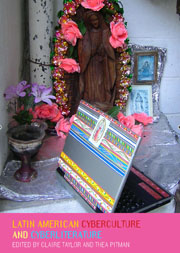Book contents
- Frontmatter
- Contents
- List of Illustrations
- Acknowledgements
- Foreword: Latin American Cyberliterature: From the Lettered City to the Creativity of its Citizens
- Notes on Contributors
- Introduction
- I Cyberculture and Cybercommunities
- 1 The New New Latin American Cinema: Cortometrajes on the Internet
- 2 Cyborgs, Cities, and Celluloid: Memory Machines in Two Latin American Cyborg Films
- 3 The Cyberart of Corpos Informáticos
- 4 Latin American Cyberprotest: Before and After the Zapatistas
- 5 Body, Nation, and Identity: Guillermo Gómez-Peña's Performances on the Web
- 6 Cyberspace Neighbourhood: The Virtual Construction of Capão Redondo
- 7 Literary E-magazines in Latin America: From Textual Criticism to Virtual Communities
- 8 Negotiating a (Border Literary) Community Online en la línea
- II Cyberliterature: Avatars and Aficionados
- A Cyberliterary Afterword: Of Blogs and Other Matters
- Conclusion: Latin American Identity and Cyberspace
- Suggested Further Reading
- Index
3 - The Cyberart of Corpos Informáticos
from I - Cyberculture and Cybercommunities
- Frontmatter
- Contents
- List of Illustrations
- Acknowledgements
- Foreword: Latin American Cyberliterature: From the Lettered City to the Creativity of its Citizens
- Notes on Contributors
- Introduction
- I Cyberculture and Cybercommunities
- 1 The New New Latin American Cinema: Cortometrajes on the Internet
- 2 Cyborgs, Cities, and Celluloid: Memory Machines in Two Latin American Cyborg Films
- 3 The Cyberart of Corpos Informáticos
- 4 Latin American Cyberprotest: Before and After the Zapatistas
- 5 Body, Nation, and Identity: Guillermo Gómez-Peña's Performances on the Web
- 6 Cyberspace Neighbourhood: The Virtual Construction of Capão Redondo
- 7 Literary E-magazines in Latin America: From Textual Criticism to Virtual Communities
- 8 Negotiating a (Border Literary) Community Online en la línea
- II Cyberliterature: Avatars and Aficionados
- A Cyberliterary Afterword: Of Blogs and Other Matters
- Conclusion: Latin American Identity and Cyberspace
- Suggested Further Reading
- Index
Summary
Within the last decade there has been a vigorous response to the challenges to established orders of knowledge posed by the ‘digital revolution’ from Brazilian artists, theorists, and practitioners, who have gained great influence within what the US social theorist Gregory Coyne has termed the new cultural axis emerging in the Americas, extending from Florida to Brazil (Hinchberger 2004). Brazilian artists' engagement with and contribution to the international cross-fertilisation of ideas within the numerous discourses of modernity is not, of course, a new phenomenon. Practitioners of the new media in Brazil are working within a tradition that was already highly receptive to, and, indeed, foreshadowed in many ways, the possibilities of engagement, interactivity and radical embodiments, and transformations of society and self promised by the new digital media. Yet the new and unprecedented opportunities for communication, dissemination and access afforded by international network systems have enabled Brazilian practitioners working with computer networks and animation, telecommunications, digital video, hypermedia and multimedia to overcome logistic, cultural and national barriers, and become key players in the international digital community.
This chapter, then, will focus on the theory and practice of one example of new media art in Brazil: corpos.org, constructed by a long-established and publicly funded group of researchers, web practitioners, and performance artists, Corpos Informáticos [Virtual Bodies].
- Type
- Chapter
- Information
- Latin American Cyberculture and Cyberliterature , pp. 70 - 85Publisher: Liverpool University PressPrint publication year: 2007



